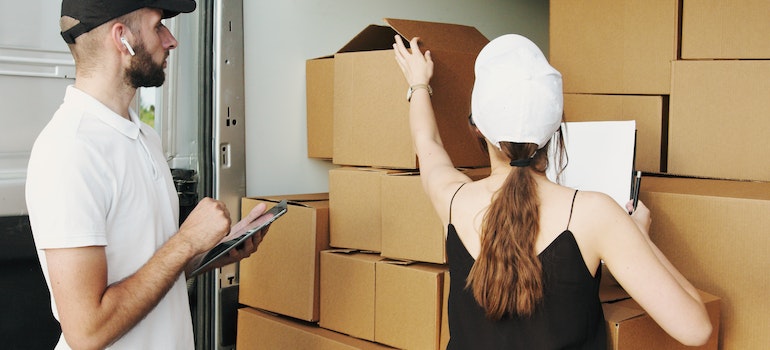Green Moving Tips for Beginners
Moving can feel like a whirlwind—so many boxes, endless to-do lists, and more waste than you’d expect. But what if you could take this opportunity to make your move better for the planet? Many of us in Seattle already strive to live sustainably, and your move doesn’t have to be an exception. With a few thoughtful changes, you can cut down on waste, use fewer resources, and still have a smooth move. You don’t need to be an eco-expert to make a difference. It’s about swapping single-use for reusable, decluttering responsibly, and thinking about long-term impact. This guide by movers and packers Seattle relies on is packed with green moving tips for beginners. Use it to help you move sustainably without adding stress to your already busy plans!
Moving Green Starts with a Few Simple Steps
Effective planning is key to making your move eco-friendly. Without preparation, it’s easy to rely on quick fixes like disposable supplies or extra trips, which can lead to more waste and higher costs. Taking the time to organize and strategize ensures a smoother process that’s kinder to the planet. Here’s how to start:
- Evaluate Your Belongings: Go through each room and decide what’s essential. Many people bring items they no longer need, wasting time, energy, and packing materials. By sorting items into categories—“keep,” “donate,” “sell,” or “recycle”—you can reduce what you pack. Donation centers across Seattle, like local Goodwill locations, welcome clothing, household goods, and furniture, helping these items find new homes instead of ending up in landfills.
- Create a Realistic Timeline: Breaking tasks into smaller steps makes the process more manageable. For instance, dedicate one week to decluttering, another to sourcing reusable packing supplies, and a final week to packing and labeling. With this approach, you’ll avoid the panic that often leads to wasteful decisions.
- Think About Moving Day Logistics: If you’re hiring Washington movers, consider asking about their environmental practices. Some companies may use lower-emission trucks or offer reusable packing materials. If moving yourself, rent reusable bins or use what you already have, such as suitcases or storage totes, to cut back on single-use supplies.
Organizing in advance will reduce unnecessary waste, streamline your efforts, and help you make greener choices along the way. It’s a small investment of time that makes a big difference for both your move and the environment.

Let Go of What You Don’t Need—Without Hurting the Planet
Decluttering before a move is a powerful way to simplify your life and embrace sustainable habits. Disposing of items responsibly reduces landfill waste while giving your belongings a chance to benefit others. Start by assessing your possessions and sorting them into categories: donate, sell, recycle, and keep.
Donate usable items to local charities or shelters where they can serve a purpose. Many organizations gladly accept clothing, household goods, and furniture. Selling valuable items online or hosting a garage sale allows you to earn extra money while lightening your load. For broken or outdated electronics, batteries, and appliances, drop them off at recycling facilities that handle these materials properly.
Avoid the temptation to toss everything into the trash. With a bit of planning, you can significantly reduce the environmental impact of decluttering. Sorting items thoughtfully ensures your belongings find a new purpose while leaving you with fewer items to move.
Smart Packing Hacks for Beginners (That Are Good for the Earth)
Packing doesn’t have to mean wasting materials. You can cut down on waste and save money by rethinking how you prepare your belongings. Start by using items you already own. Towels, blankets, and clothing make excellent padding for fragile items, eliminating the need for bubble wrap or foam.
Source boxes from local stores, community groups, or neighbors. Many stores are happy to give away sturdy boxes, and community platforms often feature people giving away moving supplies for free. Avoid purchasing packing materials that are difficult to recycle, such as Styrofoam or packing peanuts. Opt for recyclable or biodegradable alternatives when padding is necessary.
Using reusable bins is another great option among green moving tips for beginners. They are durable, stackable, and reduce reliance on cardboard boxes. Labeling bins and boxes ensures easy unpacking and avoids the need to repack. Small steps like these make packing more eco-friendly and help keep your move organized.
How to Find Movers Who Care About Sustainability
Hiring movers who prioritize sustainability adds another layer of eco-consciousness to your move. Many companies now incorporate practices like using fuel-efficient vehicles, recycling materials, and offering reusable packing supplies. Finding a company that aligns with your values may require extra research, but the result is worth it.
Begin by asking direct questions. Inquire about their vehicle emissions, packing materials, and policies for recycling or disposing of waste. Look for companies that demonstrate a genuine commitment to reducing their environmental impact.

Choosing movers with sustainable practices ensures your move has a smaller carbon footprint. While this step might take some effort, it aligns your moving process with your environmental goals and encourages greener practices within the industry.
Easy Ways to Waste Less as Moving Day Gets Closer
The days leading up to your move can create unexpected waste if you’re not careful. Taking a few extra steps to stay mindful can prevent this. Begin by focusing on your kitchen. Plan meals to use up perishable food items, reducing what needs to be packed or thrown away. Donate unopened, non-perishable food to local food banks or Move For Hunger, ensuring it doesn’t go to waste.
When packing, use suitcases, reusable totes, and laundry baskets for small items instead of single-use boxes. For larger items, consider renting reusable bins, which are sturdier and more environmentally friendly than cardboard. If you wish to buy new, unused, supplies and moving boxes in Seattle, choose recyclable or biodegradable options.
Moving Day Tips for Staying Green and Organized
Moving day can be hectic, but staying organized helps keep it sustainable and stress-free. Begin by loading the moving truck efficiently to reduce trips. Ensure the truck is packed fully with each trip, and plan your route to minimize mileage, cutting fuel use and emissions.
Bring reusable water bottles and snacks for everyone helping with the move. It prevents reliance on disposable cups, bottles, and packaging. Use durable totes or reusable containers for essential items you’ll need immediate access to at your new home, such as toiletries and tools.
Set up a designated area for any last-minute trash or recycling. Handling waste efficiently on moving day prevents items from being thrown away unnecessarily. These small actions keep your move on track and minimize its environmental impact.
Eco-Friendly Cleaning Tips for Your Old and New Homes
Cleaning your old and new homes is an unavoidable part of moving, but it doesn’t have to involve harsh chemicals or excessive waste. Switching to eco-friendly cleaning methods ensures a healthier space for everyone while reducing environmental harm. Our checklist with green moving tips for beginners cleaning their homes will help you out:
- Use natural solutions, such as a mix of vinegar and water, for cleaning glass and mirrors.
- Scrub sinks, tubs, and tiles with baking soda for a chemical-free shine.
- Opt for biodegradable, plant-based cleaning products for general surfaces.
- Replace paper towels with reusable microfiber cloths or rags.
- Choose compostable scrub pads or brushes made from sustainable materials.
For deeper cleaning, look into local refill stations where you can stock up on cleaning products without creating plastic waste. These small adjustments keep your cleaning routine sustainable and safe for you and the planet.

Set Up a Green Home from the Start
A new home is the perfect opportunity to establish eco-conscious habits after your relocation. Begin by setting up recycling and compost systems right away. Having bins in place from day one ensures proper waste management becomes part of your routine immediately.
Replace incandescent lightbulbs with energy-efficient LED options. These use less energy and last significantly longer, saving you money and reducing your environmental footprint. If the home needs additional furnishings, consider secondhand options or sustainable brands that prioritize eco-friendly materials.
Weatherproofing your home with weather strips on doors and windows can reduce energy waste by improving insulation. Installing a programmable thermostat also helps control energy usage efficiently. Starting with these steps creates a home that’s not only comfortable but also better for the environment.
Offset Your Moving Footprint Without Breaking the Bank
Every move contributes to carbon emissions, but simple steps can balance the impact. Carbon offset programs allow you to support environmental projects, such as reforestation and renewable energy, in exchange for the emissions caused by your move.
Choose local initiatives or global programs that align with your values. Many organizations offer affordable options, such as planting trees for a small fee or funding renewable energy projects. Consolidating trips and using fuel-efficient vehicles further reduces emissions without additional cost.
Offsetting doesn’t have to mean large investments. Small contributions to these programs ensure your move has a smaller environmental footprint, making a meaningful difference without straining your budget.
Common Mistakes to Avoid When Moving Sustainably
Moving sustainably requires thoughtful decisions, and certain missteps can make the process less eco-friendly. Rushing often leads to overbuying supplies or using materials that are difficult to recycle. Starting early helps you plan responsibly and avoid waste.
Many people overlook sustainable options when choosing moving services. Asking questions about practices such as using fuel-efficient vehicles, recycling materials, or offering reusable or recyclable packing supplies can help you find a moving company aligned with your values.

Improper disposal of items is another frequent issue. Electronics, batteries, and certain household items need special handling and can’t go into regular trash. Research local facilities for recycling these materials to ensure they’re disposed of properly. So, stay intentional throughout your move and avoid these common pitfalls to make the process smoother and more environmentally friendly.
Incorporate Digital Solutions for a Greener Move
Using digital tools during your move can significantly cut down on paper waste and improve organization. Replace traditional printed checklists, receipts, and contracts with digital versions to reduce the environmental impact. Apps designed for moving can help you track tasks, inventory your belongings, and even calculate your moving footprint—all without a single sheet of paper.
Electronic contracts and e-signatures streamline communication with moving companies while keeping everything paperless. For labeling, try QR codes or apps that allow you to tag and track boxes digitally. These tools save resources while also making unpacking easier, offering a clear and detailed inventory of your belongings.
In addition, using digital solutions transforms the moving process into an efficient and sustainable experience. Moreover, reducing paper waste and improving organization ensures you stay eco-conscious without sacrificing convenience or practicality.
A Fresh Start That’s Good for the Planet
Every small, eco-friendly choice during your move adds up to a bigger impact, helping to protect the environment while setting the tone for how you’ll live in your new home. In other words, moving is more than a change of address—it’s an opportunity to create new habits that align with your values.
An environmentally conscious move isn’t about being perfect; it’s about making thoughtful decisions within your means. Whether you’re rethinking how you pack, decluttering responsibly, or supporting local sustainability efforts, each step shows how easy it is to prioritize the planet without adding extra stress.
So, as you settle into your new space, keep the momentum going with our green moving tips for beginners. Sustainable living doesn’t stop after moving day; it’s a way to create a home and lifestyle you can feel proud of. With every action, you’re contributing to a greener, healthier tomorrow—for yourself and the world around you.
Why Choose Us
History
Hansen Bros. Moving & Storage is locally owned and operated by the same family for four generations, since 1890. We have a well-established reputation for service quality and reliability with a high percentage of repeat household and commercial clients.
Professionalism
We’re a certified ProMover by the American Moving and Storage Association with A+ rating with the Better Business Bureau, voted “Best in Western Washington” in 2009 and from 2011 to 2016 by KING5. Our company is fully licensed and insured and member of WMC and AMSA.
Value
Hansen Bros. Moving & Storage provide free, no-obligation in-home estimate and competitive rates, including low minimum rates for shipments moving under 300 miles. We’ve set a refund policy for unused packing materials and three Puget Sound locations to help clients save on travel fee costs.



